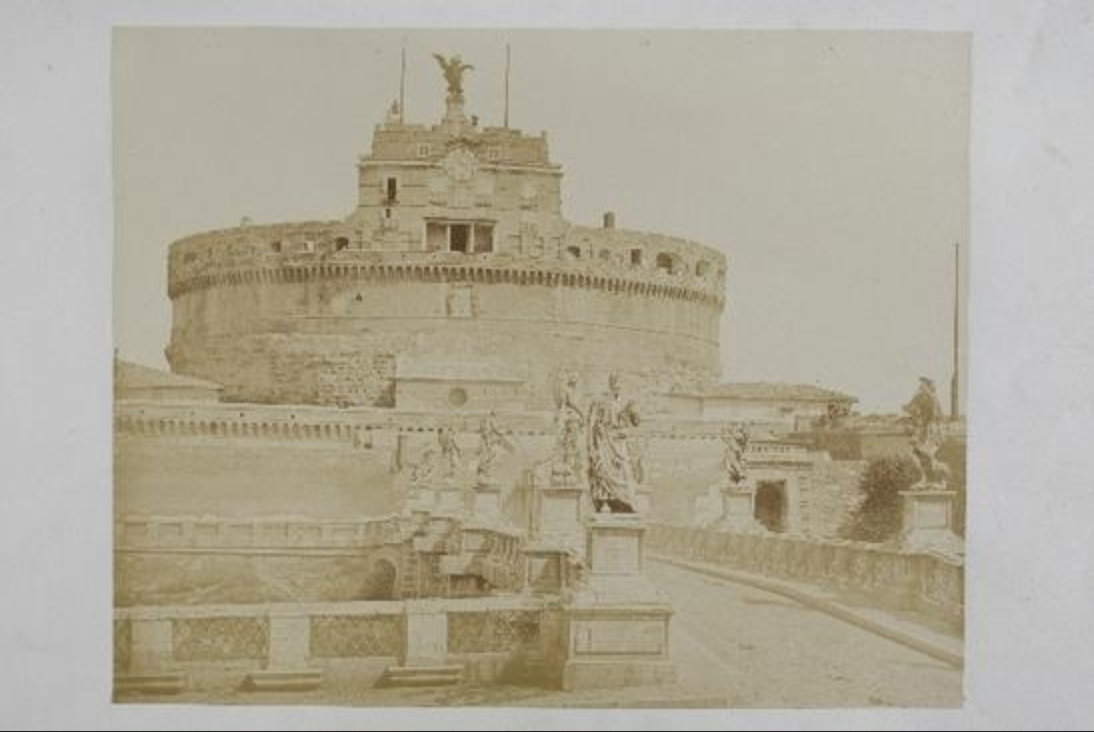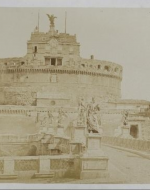Created by Stacey Smythe on Tue, 04/27/2021 - 16:31
Description:
Built by Emperor Hadrian in 134 CE as a triumphal passageway—connecting both the left and the right banks of the Tiber River, as well as the Campus Martius to the Castel Sant’Angelo—the Ponte Sant’Angelo was originally dedicated as the Pons Aelius in honor of, and in homage to Hadrian’s family; Hadrian erected the Castel to which it leads, as well. Intending it as both a mausoleum (Moles Hadriani) for himself and his family, as well as the burial place of successive Antonine emperors—with the last interment that of Caracalla (Marcus Aurelius Antoninus) in 217—the imposing bastion has served a multitude of purposes in the centuries since. With the besiegement of Rome by the invading Goths in 527, the building was repurposed as a citadel and further fortified by the addition of polygonal defensive barbicans to the four corners of the square base upon which the massive drum sits. Throughout the Middle Ages, it continued to serve as both a bastion and a prison—the goldsmith cum poet Benvenuto Cellini, and the Dominican friar cum philosopher Giordano Bruno among its more famous inmates—as well as a point of refuge for the pope and his entourage in perilous times. In the 14th century, a half-mile long covered corridor, the Passetto de Borgo, connecting St.Peter’s Basilica and the Castel was constructed to provide safe passage between the two, and in the 16th century a section of the building underwent renovations to include sumptuous and resplendent papal apartments. (Pope Clement VII, for example, fled the Vatican during the sack of Rome by the troops of Holy Roman Emperor Charles V in 1527 and traveled via the corridor to the Castel where he remained ensconced until the threat had passed.) The Castel’s modern name derives from the apocryphal story in which Gregory the Great—in the first year of his pontificate and heading a procession of penitence and prayer for the end of the plague that was decimating the population of Rome in 590—had a vision of the Archangel Michael wiping blood from his sword and then sheathing it, an act which the pope interpreted as a sign that God had been appeased and the suffering would soon abate. The marble sculpture embodying this legendary moment, however, would not replace the bronze—and most likely gilded—sculpture of Hadrian and his quadriga (a chariot drawn by four horses) crowning the round temple in which the multi-tiered edifice culminated, until 1536; in 1753 it was replaced by the bronze copy that sits there today. The bridge was rechristened as the Ponte Sant’Angelo (Bridge of Angels) in the late 17th century with the addition of a new balustrade punctuated at regular intervals by ten angel sculptures, each holding an instrument of Christ’s Passion. Designed and executed by Gian Lorenzo Bernini and his studio, the statues exhibit a theatricality and dynamism that is decidedly baroque. Thus adorned, the ponte literally became a ‘bridge of angels.’ Regardless of its moniker, its ornamentation, or its originally intended function, the bridge has served as a thoroughfare for pilgrims traveling to and from St. Peter’s Basilica as far back as the Middle Ages. In the Divine Comedy, Dante wrote: “Because the throngs were vast the year/of Jubilee, the Romans had to find a way/to let the people pass across the bridge,/so that all those on one side face the castle,/heading over to Saint Peter’s,/these, on the other, heading toward the mount” (Inf. xviii.28-33).
Copyright:
Associated Place(s)
Part of Group:
Featured in Exhibit:
Artist:
- Robert MacPherson


